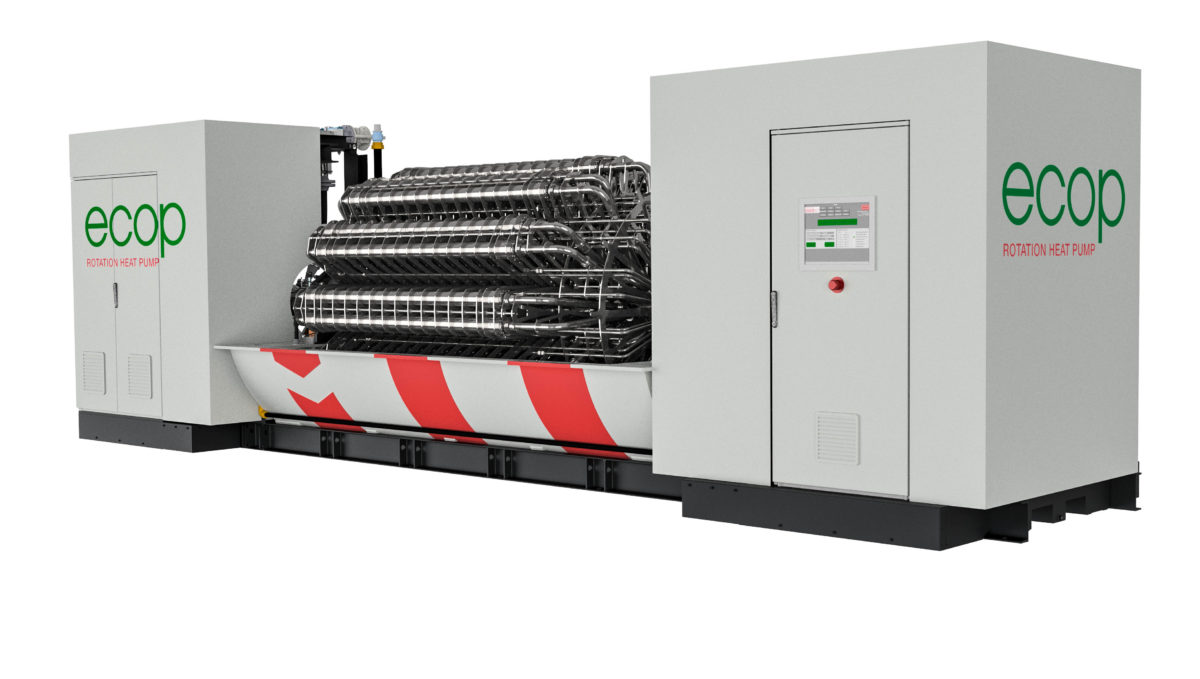Austrian technology company ecop Technologies GmbH has developed a rotation heat pump based on a 1-phase thermodynamic cyclic process that is intended for use in high-scale industrial projects.
“Our system has already been used in combination with power generation from biomass but we could ould think of a well and efficient working system in combination with solar photovoltaics,” the company's simulation engineer, Andreas Längauer, told pv magazine. “We have already done some analyses and got requests about that which look really interesting and promising.”
The system reportedly has a coefficient of performance (COP) of 4.0 – 7.0 that is around 70% higher than that compared to conventional heat pumps, which ecop estimates at 2.5 – 5.0. “We have already improved the COP a lot and the system works very well. But, of course, we are still developing and trying to make our rotation heat pump work even better,” Längauer went on to say, noting that this COP level can be achieved already at a temperature of 150 degrees Celsius.
The machine measures 2.2 x8.1×2.7m and weighs in at 18t. It works through an anticlockwise running Joule process, during which there is no phase transition of the working medium that always remains gaseous. It uses an inert gas which the company says has zero global warming potential, is widely available, inexpensive, and does not pose any security issues.
The gas circulates in a closed cycle, which rotates around an axis. The heat exchangers are positioned closer and farther away from the axis of rotation and connected to lines, in order to establish a thermodynamic cyclic process. During rotation, the centrifugal force increases with increasing distance from the axis of rotation, and the working gas is compressed by the centrifugal force.
To operate the cycle, the working gas circulates in the closed cycle by means of a fan. The strong pressure in the off-axis areas raises the gas temperature and the generated heat is then conveyed into a sink via a heat exchanger. “When the gas that is cooled that way expands again, its temperature changes to a lower level due to the flow against the centrifugal force and can thereby take up heat again at the source via the heat exchanger close to the axis,” the company explained.
In its current form, the heat pump has a capacity of 700kW and a technology readiness level (TRL) of seven. The TRL measures the maturity of technology components for a system and is based on a scale from one to nine, with nine representing mature technologies for full commercial application.
The machine could be used in combination with district heating and industrial processes such as distillation, pasteurization, washing, and cooking. “The rotation heat pump may be sold at around €490,000, where also good options for funding are given,” Längauer said. “Since our technology is quite new and innovative, this is a very good and attractive way to build up financing.”
The project has received funding from the European Union Horizon 2020 research and innovation program.
This content is protected by copyright and may not be reused. If you want to cooperate with us and would like to reuse some of our content, please contact: editors@pv-magazine.com.




By submitting this form you agree to pv magazine using your data for the purposes of publishing your comment.
Your personal data will only be disclosed or otherwise transmitted to third parties for the purposes of spam filtering or if this is necessary for technical maintenance of the website. Any other transfer to third parties will not take place unless this is justified on the basis of applicable data protection regulations or if pv magazine is legally obliged to do so.
You may revoke this consent at any time with effect for the future, in which case your personal data will be deleted immediately. Otherwise, your data will be deleted if pv magazine has processed your request or the purpose of data storage is fulfilled.
Further information on data privacy can be found in our Data Protection Policy.